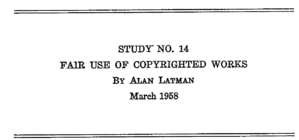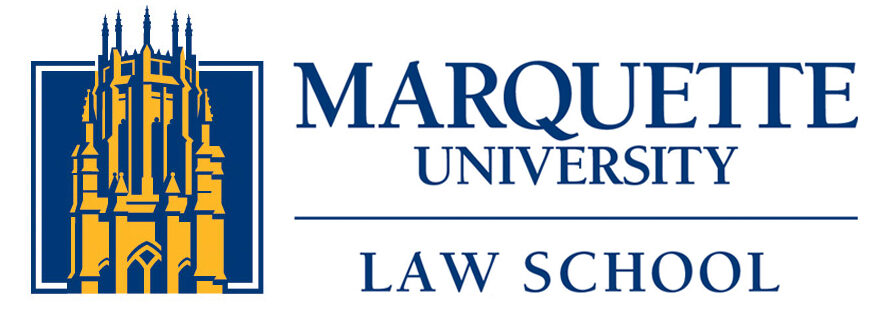 The AWF oral argument was yesterday morning — here’s SCOTUSBlog’s recap — but I’ll save my thoughts on it for later. At the end of my last post, I had reached the 1950s. At that time, the term “fair use” was being used in a desultory way to refer to all instances of noninfringement, whether due to limitations on the scope of copyright or some sort of exception. As Arthur Weil put it, “‘fair use’ simply means a use which is legally permissive.”
The AWF oral argument was yesterday morning — here’s SCOTUSBlog’s recap — but I’ll save my thoughts on it for later. At the end of my last post, I had reached the 1950s. At that time, the term “fair use” was being used in a desultory way to refer to all instances of noninfringement, whether due to limitations on the scope of copyright or some sort of exception. As Arthur Weil put it, “‘fair use’ simply means a use which is legally permissive.”
That was where things stood when the Copyright Office, in 1955, began to conduct a series of studies to pave the way for a thorough-going revision of the 1909 Copyright Act. The 1909 Act contained no reference to fair use at all; the doctrine was entirely a judicial creation. So one question was whether a new, revised copyright act should take official notice of fair use, and if so, what it should say.
The “fair use” study was assigned to a young attorney, Alan Latman, then a rising star in the copyright field. Latman’s report was one of the key founding documents for what eventually became Section 107 of the 1976 Copyright Act, the fair use statute that we have today, and has been cited repeatedly by the Supreme Court in its attempts to divine the contours of fair use.
In his report, Latman immediately identified a significant problem with “fair use”: what courts were referring to as a single concept was in fact two different things. One set of cases used “fair use” to refer to “a technical infringement which is nevertheless excused;” another set used it to refer to “a use falling outside the orbit of copyright protection and hence never an infringement at all.”
Latman noted that this dual usage of the term had led to some confusion in the cases, and arguably mixed issues that belonged to different portions of the analysis, liability vs. some sort of defense. It arguably mixed issues, but Latman was cautious in drawing conclusions: “Employing ‘fair use’ in its broad connotation — such as signifying an appropriation of unprotected ideas — has been said to add ‘needless confusion to an already confused area of the law.’ Whether or not the confusion is needless is not altogether clear.” Latman seemed to sense that the broader, non-liability form of “fair use” may have been doing some important work in the infringement inquiry as well, which could be jeopardized if the concept was trimmed down.
Nevertheless, Latman focused the remainder of his report on the role of fair use as an exception to liability, not as the limit to liability. He identified several particular uses that had been excused under the doctrine of fair use: incidental uses, reviews and criticism, parody and burlesque, scholarly works and compilations, personal or private uses, news, use in litigation, and use for nonprofit or governmental purposes. Then Latman reviewed various attempts to define, with a set of criteria, what these situations had in common.
Latman himself appeared to believe that there was no single justification for all of the fair use exceptions, and thus that no single definition or set of criteria would work. But he was careful to not come right out and say that, leaving it as a determination for Congress. In the conclusion of the report, he listed the various options that Congress had in what would become the 1976 Act. One was to follow the precedent of the 1909 Act and not say anything about fair use. A second was to recognize the existence of the doctrine in statutory language — “fair use is not an infringement” — but not otherwise define it. A third was to attempt to specify “general criteria” for the doctrine, such as a set of relevant factors. And the fourth was to draft language to carve out specific situations, such as reviews or parodies, but leave others unaddressed.
Although Latman did not recommend any particular approach, he was most skeptical about the third, specifying a single set of general criteria. “This would represent the boldest attempt to treat the problem,” he wrote, in a report that otherwise portrays caution as a virtue. While the “objective of such an approach” would be a “somewhat greater degree of predictability,” Latman predicted that it would be “beset by the practical obstacles facing any attempt to codify common law or to legislate in an area of subtle factual interaction.” Following Latman’s lead, most of the commenters that the Copyright Office solicited to respond to his report — including then-current and future luminaries such as Walter Derenberg, Ralph Brown, and Melville Nimmer — recommended against adopting a definition of fair use, and instead either leaving it unaddressed, or providing only a bare recognition of the doctrine.
But the Copyright Office, in its 1961 Report to Congress, went in a different direction, and when it did, it focused on the portion of Latman’s report that summarized past attempts to give the doctrine of fair use a coherent framework. Chief among those was a law review article published in 1954 by Judge Leon Yankwich of the Southern District of California, the district that then contained Hollywood. Judge Yankwich had established a reputation as being a copyright expert in the federal judiciary — it was Judge Yankwich that had coined the term “scènes à faire” — and in the 1950s he took his hand at trying to bring clarity to a number of copyright doctrines, including originality and fair use.
Yankwich’s primary target in his article was the practice that he had observed of noting that various quotations in scholarly or nonfiction works were “reprinted with the permission of the publisher;” Yankwich argued at length that copyright law was clear that no such permission was needed. But in the course of that discussion, Yankwich tried to identify a set of criteria that would determine when fair use would and would not exist. Those criteria, he said, “in the American cases stem from a statement by Mr. Justice Story,” namely, the Folsom factors. Yankwich boiled those down into a “test” that he said had “evolved to determine whether the taking of copyrighted material does or does not exceed the limits of ‘fair use'”: “(1) the quantity and importance of the portions taken; (2) their relation to the work of which they are a part; (3) the result of their use upon the demand for the copyrighted publication.”
Unfortunately, Judge Yankwich was a bit loose with his language in his article; there was no widely followed test that involved courts walking through the Folsom factors to determine if a use was fair. In fact, it was the rare case that did so. Nevertheless, in summarizing what others had said about fair use, Latman quoted Yankwich’s reworking of Folsom, and added a fourth factor that had been suggested by others: “the nature of the works involved.” Latman suggested that “[t]his factor might explain what appears to be a stricter rule in the case of compilations than in more scholarly works.”
The Copyright Office in its 1961 Report to Congress, that formed the basis for the bills that eventually became the 1976 Act, took the approach Latman described as “beset by practical obstacles,” and set out to define fair use with a set of criteria. And the criteria they used were those that Latman had helpfully pointed them to, Judge Yankwich’s version of the Folsom factors, plus Latman’s own addition (trimmed down to looking only at the plaintiff’s work):
(1) the purpose of the use,
(2) the nature of the copyrighted work,
(3) the amount and substantiality of the material used in relation to the copyrighted work as a whole, and
(4) the effect of the use on the copyright owner’s potential market for his work.
Thus was the ancient doctrine of fair use presented to Congress, as if it had always been that way.

